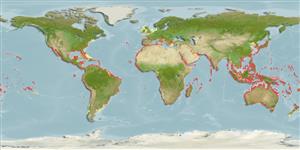Common names from other countries
Classification / Names / Names
Nomi Comuni | Sinonimi | Catalog of Fishes (gen., sp.) | ITIS | CoL | WoRMS
Environment: milieu / climate zone / depth range / distribution range
Ecologia
; distribuzione batimetrica 0 - 26 m (Ref. 102128). Tropical
Atlantic Ocean: from Texas, USA to Saõ Paulo, Brazil, including Gulf of Mexico, Bermuda and the Caribbean, east to the Mediterranean Sea and south to Angola, including Azores, Madeira, Salvage, Canary and Cape Verde Island; Indian Ocean: from the Arabian Sea, including Persian Gulf and the Red Sea, south to South Africa including Aldabra Islands, Seychelles, Madagascar, Rodrigues Island and Réunion, east to Sri Lanka; in the Bay of Bengal from Bangladesh to South Australia, including Laccadive Islands, Maldives, Andaman Islands, Nicobar Islands and Diego Garcia Atoll; Pacific Ocean: from Japan to the South China Sea south to New Zealand, including Tasmania, Federated States of Micronesia, Marshall Islands, Fiji and Lord Howe Island, east to California, USA, including French Polynesia, Hawaiian Islands, Samoan Archipelago; south in Mexico and Chile, including Easter Island. Tropical to subtropical.
Length at first maturity / Size / Peso / Age
Maturity: Lm ? range ? - ? cm
Thalli light brown or yellowish brown, characteristically net-like due to numerous perforations
which range from 0.5 to 12.0mmin diameter; in between the holes, the fleshy strands have enrolled margins and vary from 0.5 to 2.5 mm in thickness. Thalli form extensive mats (Ref. 80758).
Used for human consumption: mixed with other vegetables in salads; contains iodine, mannitol, protein, vitamins, folic and folinic acids; also used for animal feed and fertilizer; has growth regulator substances similar to auxin, gibberellin, and cytokinin; contains alginic acid. A highly seasonal species, abundant only during the summer months. In protected coves, abundant during spring and summer months (Ref. 80758). A highly seasonal species, abundant only during the summer months. A dominant component of the intertidal seaweed community; an abundant species during spring and summer months in protected coves, reef flats and bays at the lower littoral zone near the low tide mark. Either attached to rocky substrate, often associated with Colpomenia sinuosa, or forming thick piles on sandy bottom, or floating (Ref. 80758).
Guiry, M.D. and G.M. Guiry. 2009. (Ref. 80701)
IUCN Red List Status (Ref. 130435)
CITES status (Ref. 108899)
Not Evaluated
Not Evaluated
Threat to humans
Human uses
Pesca: commerciale
| FishSource |
Strumenti
Informazioni ulteriori
Age/SizeAccrescimentoLength-weightLength-lengthMorfologiaLarveAbbondanza
Fonti Internet
Estimates based on models
Preferred temperature
(Ref.
115969): 17.6 - 29.2, mean 27.4 (based on 6834 cells).
